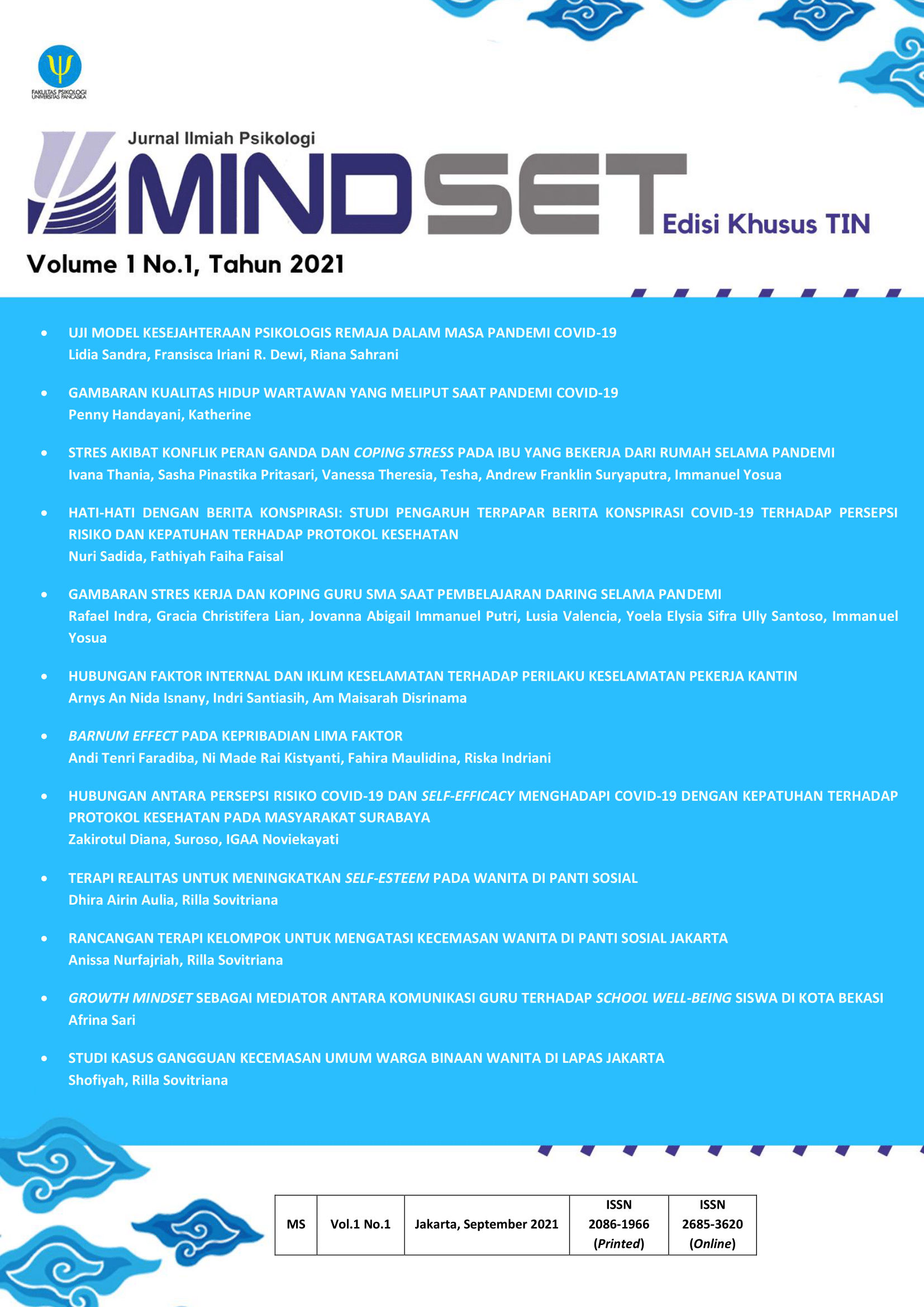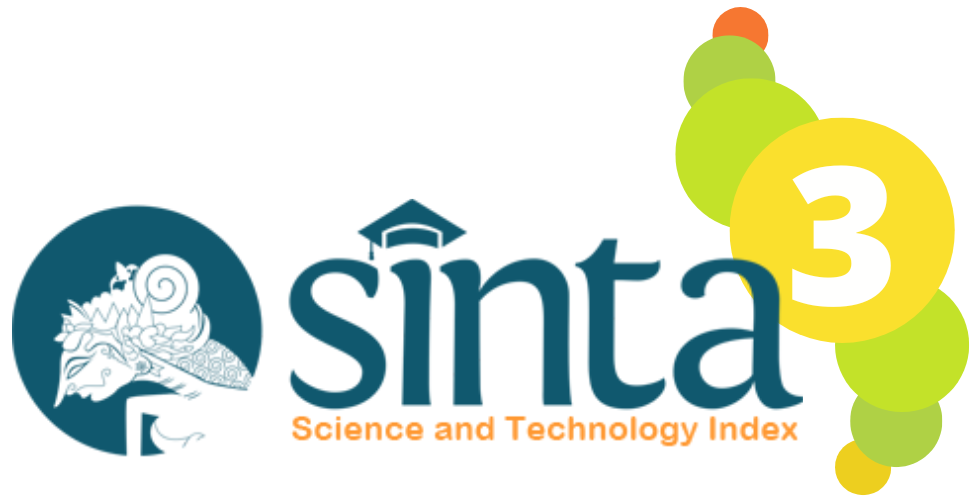Hubungan antara Persepsi Risiko COVID-19 dan Self-Efficacy Menghadapi COVID-19 dengan Kepatuhan terhadap Protokol Kesehatan pada Masyarakat Surabaya
Abstract
Pada tahun 2020 seluruh dunia sedang menghadapi pandemi virus corona (COVID-19) yang menyerang pernapasan manusia dan dapat menyebabkan kematian. Cara untuk menghentikan dan memperlambat penularan virus COVID-19 menurut WHO (World Health Organization) adalah dengan menerapkan protokol kesehatan. Keyakinan atau kepercayaan seseorang tentang potensi bahaya sangat penting dalam membentuk perilaku kesehatan dengan mematuhi protokol kesehatan. Tujuan dalam penelitian ini adalah untuk mencari hubungan antara variable persepsi risiko COVID-19, self-efficacy dan kepatuhan protokol kesehatan pada masyarakat Surabaya. Subjek dalam penelitian ini adalah masyarakat Surabaya yang berusia 20-30 tahun sebanyak 256 responden. Teknik analisis data dalam penelitian ini menggunakan uji Rho Spearman yang diolah dengan bantuan SPSS (Statistical Product and Service Solution) versi 20.0 for windows. Hasil analisis (1) Rho Spearman menunjukkan persepsi risiko COVID-19 berkorelasi positif dengan kepatuhan (rho = 0,591; p < 0,01). Hasil analisis (2) Rho Spearman self-efficacy berkorelasi positif dengan kepatuhan (rho = 0,376; p < 0,01).
References
Abdul, A. R., Nuraini, A., Elisa, K., & Iman, S. (2020). Faktor-Faktor Psikososial dari Ketidakpatuhan Masyarakat pada Masa Pandemik. Artikel, 19, 1-10.
Abusabha, R., & Acchterberg, C. (1997). Review of self efficacy and locus of control for nutritiona. Journal American Dietitian Association, 97, 1122-1132.
Arini, A. T. (2016). Persepsi risiko di Indonesia: Tinjauan kualitatif sistematik. Buletin Psikologi, 20(1-2), 66-81. https://doi.org/10.22146/bpsi.11949
Blass, T. (1991). Understanding behavior in the Milgram Obedience Experiment: The role of personality, situations, and their interactions. Journal of Personality and Social Psychology, 60(3), 398-413. https://doi.org/10.1037/0022-3514.60.3.398
Brewer, N. T., Chapman, G. B., Gibbons, F. X., Gerrard, M., McCaul, K. D., & Weinstein, N. D. (2017). Meta-analysis of the relationship between risk perception and health behavior: The example of vaccination. Health Psychology, 26(2), 136-145. https://doi.org/10.1037/0278-6133.26.2.136
Brewer, N. T., Chapman, G. B., Rothman, A. J., Leask, J., & Kempe, A. (2017). Increasing vaccination: Putting psychological science into action. Psychological Science in the Public Interest, 18(3), 149-207. https://doi.org/10.1177/1529100618760521
Carlucci, L., D’ambrosio, I., & Balsamo, M. (2020). Demographic and attitudinal factors of adherence to quarantine guidelines during covid-19: The italian model. Frontiers in Psychology, 11(October), 1-13. https://doi.org/10.3389/fpsyg.2020.559288
Cori, L., Bianchi, F., Cadum, E., & Anthonj, C. (2020). Risk perception and covid-19. International Journal of Environmental Research and Public Health, 17(9). https://doi.org/10.3390/ijerph17093114
Dryhurst, S., Schneider, C. R., Kerr, J., Freeman, A. L. J., Recchia, G., van der Bles, A. M., & van der Linden, S. (2020). Risk perceptions of COVID- 19 around the world. Journal of Risk Research, 23(7-8), 994-1006. https://doi.org/10.1080/13669877.2020.1758193
Leppin, A., & Aro, A. R. (2009). Risk perceptions related to SARS and avian influenza: Theoretical foundations of current empirical research. International Journal of Behavioral Medicine, 16(1), 7-29. https://doi.org/10.1007/s12529-008-9002-8
Martos-Méndez, M. J. (2015). Self-efficacy and adherence to treatment: the mediating effects of social support. Journal of Behavior, Health & Social Issues, 7(2), 19-29. https://doi.org/10.5460/jbhsi.v7.2.52889
Milgram, S. (1963). Behavioral study of obedience. Journal of Abnormal and Social Psychology, 67(4), 371-378. https://doi.org/10.1037/h0040525
Plohl, N., & Musil, B. (2021). Modeling compliance with COVID-19 prevention guidelines: The critical role of trust in science. Psychology, Health and Medicine, 26(1), 1-12. https://doi.org/10.1080/13548506.2020.1772988
Roma, P., Monaro, M., Muzi, L., Colasanti, M., Ricci, E., Biondi, S., & Mazza, C. (2020). How to improve compliance with protective health measures during the covid-19 outbreak: Testing a moderated mediation model and machine learning algorithms. International Journal of Environmental Research and Public Health, 17(19), 1-17. https://doi.org/10.3390/ijerph17197252
Rundmo, T., & Iversen, H. (2004). Risk perception and driving behaviour among adolescents in two Norwegian counties before and after a traffic safety campaign. Safety Science, 42(1), 1-21. https://doi.org/10.1016/S0925-7535(02)00047-4
Sinuraya, R. K., Destiani, D. P., Puspitasari, I. M., & Diantini, A. (2018). Medication adherence among hypertensive patients in primary healthcare in Bandung city. Indonesian Journal of Clinical Pharmacy, 7(2), 124-133. https://doi.org/10.15416/ijcp.2018.7.2.124
Slovic, P., Fischhoff, B., Lichtenstein, S., & Roe, F. J. C. (1981). Perceived risk: Psychological factors and social implications. Proceedings of the Royal Society of London. A. Mathematical and Physical Sciences, 376(1764), 17-34. https://doi.org/10.1098/rspa.1981.0073
Yıldırım, M., & Güler, A. (2020). Factor analysis of the COVID-19 perceived risk scale: A preliminary study. Death Studies, 0(0), 1-8. https://doi.org/10.1080/07481187.2020.1784311










